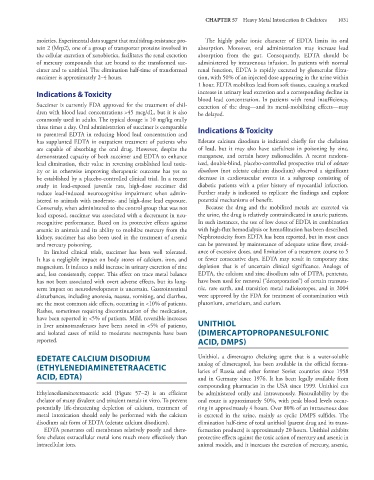Page 1045 - Basic _ Clinical Pharmacology ( PDFDrive )
P. 1045
CHAPTER 57 Heavy Metal Intoxication & Chelators 1031
moieties. Experimental data suggest that multidrug-resistance pro- The highly polar ionic character of EDTA limits its oral
tein 2 (Mrp2), one of a group of transporter proteins involved in absorption. Moreover, oral administration may increase lead
the cellular excretion of xenobiotics, facilitates the renal excretion absorption from the gut. Consequently, EDTA should be
of mercury compounds that are bound to the transformed suc- administered by intravenous infusion. In patients with normal
cimer and to unithiol. The elimination half-time of transformed renal function, EDTA is rapidly excreted by glomerular filtra-
succimer is approximately 2–4 hours. tion, with 50% of an injected dose appearing in the urine within
1 hour. EDTA mobilizes lead from soft tissues, causing a marked
Indications & Toxicity increase in urinary lead excretion and a corresponding decline in
blood lead concentration. In patients with renal insufficiency,
Succimer is currently FDA approved for the treatment of chil- excretion of the drug—and its metal-mobilizing effects—may
dren with blood lead concentrations >45 mcg/dL, but it is also be delayed.
commonly used in adults. The typical dosage is 10 mg/kg orally
three times a day. Oral administration of succimer is comparable Indications & Toxicity
to parenteral EDTA in reducing blood lead concentration and
has supplanted EDTA in outpatient treatment of patients who Edetate calcium disodium is indicated chiefly for the chelation
are capable of absorbing the oral drug. However, despite the of lead, but it may also have usefulness in poisoning by zinc,
demonstrated capacity of both succimer and EDTA to enhance manganese, and certain heavy radionuclides. A recent random-
lead elimination, their value in reversing established lead toxic- ized, double-blind, placebo-controlled prospective trial of edetate
ity or in otherwise improving therapeutic outcome has yet to disodium (not edetate calcium disodium) observed a significant
be established by a placebo-controlled clinical trial. In a recent decrease in cardiovascular events in a subgroup consisting of
study in lead-exposed juvenile rats, high-dose succimer did diabetic patients with a prior history of myocardial infarction.
reduce lead-induced neurocognitive impairment when admin- Further study is indicated to replicate the findings and explore
istered to animals with moderate- and high-dose lead exposure. potential mechanisms of benefit.
Conversely, when administered to the control group that was not Because the drug and the mobilized metals are excreted via
lead exposed, succimer was associated with a decrement in neu- the urine, the drug is relatively contraindicated in anuric patients.
rocognitive performance. Based on its protective effects against In such instances, the use of low doses of EDTA in combination
arsenic in animals and its ability to mobilize mercury from the with high-flux hemodialysis or hemofiltration has been described.
kidney, succimer has also been used in the treatment of arsenic Nephrotoxicity from EDTA has been reported, but in most cases
and mercury poisoning. can be prevented by maintenance of adequate urine flow, avoid-
In limited clinical trials, succimer has been well tolerated. ance of excessive doses, and limitation of a treatment course to 5
It has a negligible impact on body stores of calcium, iron, and or fewer consecutive days. EDTA may result in temporary zinc
magnesium. It induces a mild increase in urinary excretion of zinc depletion that is of uncertain clinical significance. Analogs of
and, less consistently, copper. This effect on trace metal balance EDTA, the calcium and zinc disodium salts of DTPA, pentetate,
has not been associated with overt adverse effects, but its long- have been used for removal (“decorporation”) of certain transura-
term impact on neurodevelopment is uncertain. Gastrointestinal nic, rare earth, and transition metal radioisotopes, and in 2004
disturbances, including anorexia, nausea, vomiting, and diarrhea, were approved by the FDA for treatment of contamination with
are the most common side effects, occurring in <10% of patients. plutonium, americium, and curium.
Rashes, sometimes requiring discontinuation of the medication,
have been reported in <5% of patients. Mild, reversible increases
in liver aminotransferases have been noted in <5% of patients, UNITHIOL
and isolated cases of mild to moderate neutropenia have been (DIMERCAPTOPROPANESULFONIC
reported. ACID, DMPS)
EDETATE CALCIUM DISODIUM Unithiol, a dimercapto chelating agent that is a water-soluble
(ETHYLENEDIAMINETETRAACETIC analog of dimercaprol, has been available in the official formu-
laries of Russia and other former Soviet countries since 1958
ACID, EDTA) and in Germany since 1976. It has been legally available from
compounding pharmacies in the USA since 1999. Unithiol can
Ethylenediaminetetraacetic acid (Figure 57–2) is an efficient be administered orally and intravenously. Bioavailability by the
chelator of many divalent and trivalent metals in vitro. To prevent oral route is approximately 50%, with peak blood levels occur-
potentially life-threatening depletion of calcium, treatment of ring in approximately 4 hours. Over 80% of an intravenous dose
metal intoxication should only be performed with the calcium is excreted in the urine, mainly as cyclic DMPS sulfides. The
disodium salt form of EDTA (edetate calcium disodium). elimination half-time of total unithiol (parent drug and its trans-
EDTA penetrates cell membranes relatively poorly and there- formation products) is approximately 20 hours. Unithiol exhibits
fore chelates extracellular metal ions much more effectively than protective effects against the toxic action of mercury and arsenic in
intracellular ions. animal models, and it increases the excretion of mercury, arsenic,

